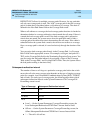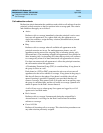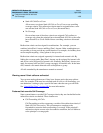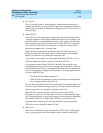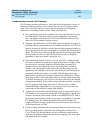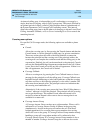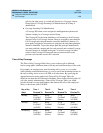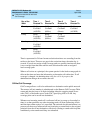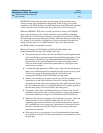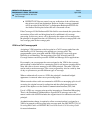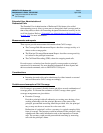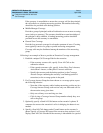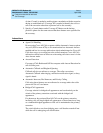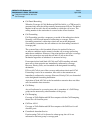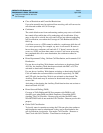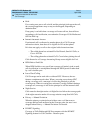
DEFINITY ECS Release 8.2
Administrator’s Guide
555-233-506
Issue 1
April 2000
Features and technical reference
1211Call Coverage
20
DEFINITY ECS provides the means of performing call classification on an
off-net coverage call to determine its disposition. If the off-net call is carried
completely over ISDN facilities to its final destination, then ISDN trunk signaling
is used to monitor the call. Otherwise, the system uses a call classifier port.
When the DEFINITY ECS tries to classify an off-net coverage call (CCRON)
using a call classifier port, the system introduces an unavoidable cut-through
delay while the call classifier port attempts to identify an answered call. Neither
the originating nor the answering party can hear each other during this delay of up
to 1 second. A call classifier is attached to all off-net coverage calls made over
analog facilities and also over ISDN facilities if the call is interworked to
non-ISDN facilities on the public network.
When the Coverage of Calls Redirected Off-Net Enabled field on the
System-Parameters Coverage-Forwarding screen is
y:
■ The system monitors off-net calls (call classification) and brings them back
to the switch if they are not answered within the defined time interval. (Set
this interval in the Off-Net Cvg Subsequent Redirection/CFWD No Ans
Interval field on the System-Parameters Coverage-Forwarding screen.)
Calls also return to the switch if the system detects a call progress tone,
such as busy or reorder.
■ A simulated bridge appearance (SBA) is put on the principal and the green
lamp is put in flashing mode; the principal can pick up the call at any time.
You have the option of dispensing with call classification (and
consequently the SBA) on a final CCRON coverage point.
■ When a call classifier port is used to classify the call, the switch plays local
ringback tone to the caller while the off-net call is being classified,
concealing from the caller what is happening on the public network. When
the call is answered off-net, it is likely that the first few syllables spoken by
the answering party will not be heard by the calling party.
■ If any party on the call is on HOLD when the call routes off net, the call
classifier is removed from the call. The call behaves in the same manner as
off-net calls when the Coverage of Calls Redirected Off-Net field is
n.
■ While an off-net call is undergoing call classification, any party who is not
already on the call will be unable to bridge onto the call. Also, the
originating party cannot release the call, conference anyone else onto the
call, or transfer the call to a new party. Once the call is answered off-net or
the call is returned to the switch for further call processing, then these
restrictions are removed.
■ If the last point in a coverage path is an off-net destination and no trunks
are available to route the call, the switch attempts to re-terminate the call to
the principal.



